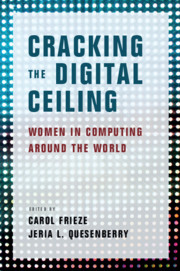Book contents
- Cracking the Digital Ceiling
- Cracking the Digital Ceiling
- Copyright page
- Contents
- Contributors
- Acknowledgments
- Introduction
- Part I Global Perspectives
- 1 An Inegalitarian Paradox
- 2 A Global Perspective on Women in Information Technology
- 3 Field Studies of Women in Europe, North America, Africa, and Asia-Pacific
- Part II Regional Perspectives
- Part III Cultural Perspectives from the United States and Europe
- Part IV Cultural Perspectives from Asia-Pacific
- Conclusion
- Notes
- Index
- References
3 - Field Studies of Women in Europe, North America, Africa, and Asia-Pacific
A Theoretical Explanation for the Gender Imbalance in Information Technology
from Part I - Global Perspectives
Published online by Cambridge University Press: 10 October 2019
- Cracking the Digital Ceiling
- Cracking the Digital Ceiling
- Copyright page
- Contents
- Contributors
- Acknowledgments
- Introduction
- Part I Global Perspectives
- 1 An Inegalitarian Paradox
- 2 A Global Perspective on Women in Information Technology
- 3 Field Studies of Women in Europe, North America, Africa, and Asia-Pacific
- Part II Regional Perspectives
- Part III Cultural Perspectives from the United States and Europe
- Part IV Cultural Perspectives from Asia-Pacific
- Conclusion
- Notes
- Index
- References
Summary
Diverse perspectives coming from a diversity of people in the information technology (IT) profession yields benefits both in terms of products and services provided to consumers and in terms of employment opportunities presented to those who would work in this field (Trauth et al., 2006a). In this regard the gender imbalance presents an important challenge to researchers, teachers, and employers. Overcoming the barriers to greater diversity in the field also requires an understanding of the context in which they occur and can be addressed.
- Type
- Chapter
- Information
- Cracking the Digital CeilingWomen in Computing around the World, pp. 61 - 72Publisher: Cambridge University PressPrint publication year: 2019



